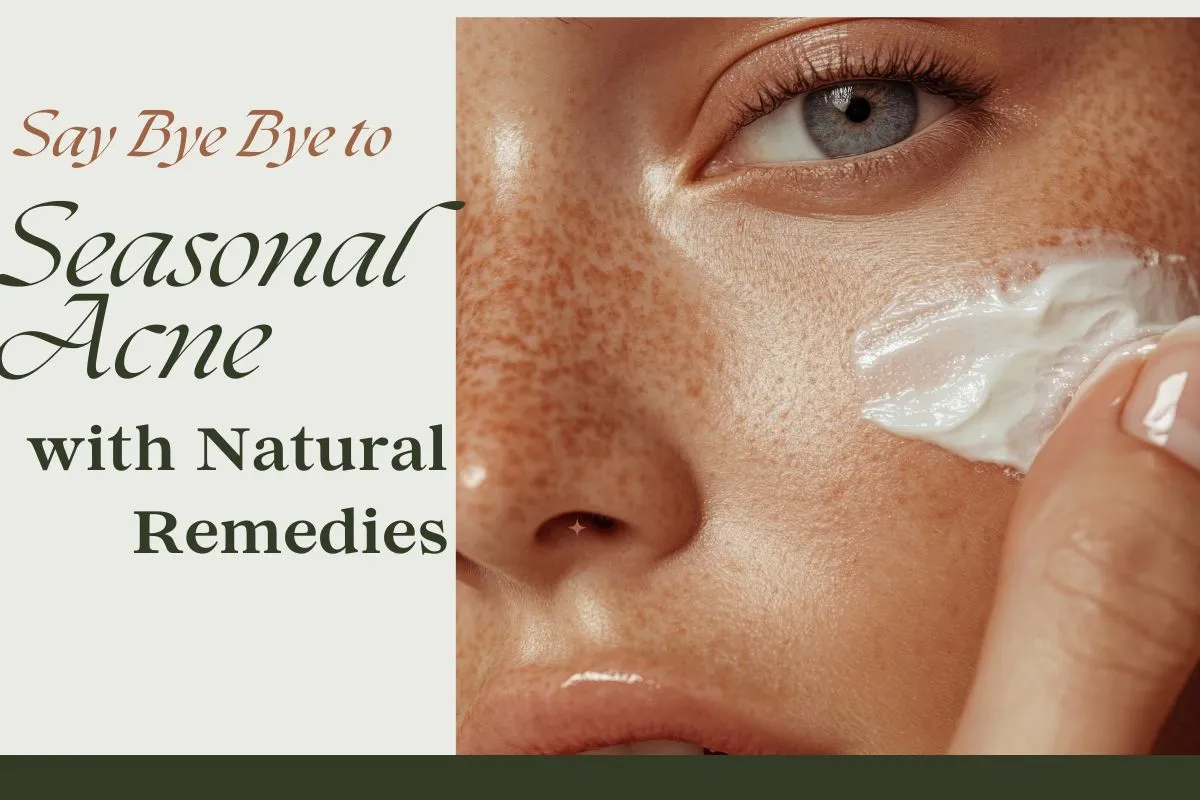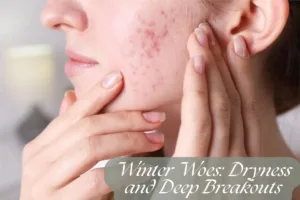No products in the cart.

Seasonal Breakouts? Natural Remedies by Season
Seasonal acne is more than just a few extra pimples popping up; it’s your skin’s way of reacting to changing weather, humidity, and lifestyle patterns. Whether it’s summer breakouts caused by sweat and sun or dry skin leading to clogged pores in winter, understanding how each season affects your skin is key to managing flare-ups naturally.
But what if each season held a secret remedy tailored by nature itself? In this blog, we’ll uncover the most powerful and soothing natural skin care for pimples, divided by season. You’ll discover easy-to-use remedies, DIY masks, and skin-loving tips using natural ingredients that work with your skin’s rhythm, not against it. Curious which season brings the most stubborn breakouts or the most healing solutions? Let’s dive in!
Summer Acne: Beat the Heat with Nature

Summer may be a season of sunshine and adventure, but for many, it’s also when seasonal acne flares up the most. The combination of scorching temperatures, high humidity, and excessive sweating turns your skin into a perfect breeding ground for clogged pores and unwanted summer breakouts. These pimples tend to appear not just on your face, but also on your back, chest, and shoulders especially in people with oily or acne-prone skin.
What makes summer acne particularly stubborn is how heat and sweat interact with everyday products like sunscreen or makeup. These can mix with sebum and bacteria, trapping dirt and sweat deep into the pores. Plus, with increased outdoor activity, your skin is more exposed to UV rays, pollution, and heat-induced dehydration, which paradoxically leads your body to produce even more oil to compensate. All these factors together trigger a frustrating cycle of pimples from the heat and unless treated mindfully, they can worsen over time.
Why Summer Breakouts Happen: Deconstructing the Triggers
1.Excessive Sweating
Hot weather makes your sweat glands hyperactive. As sweat sits on your skin, it can mix with oils and bacteria, clogging your pores and resulting in inflamed blemishes.
2. Clogged Pores from Sunscreen and Makeup
While sunscreen is essential, certain chemical sunscreens can be heavy and comedogenic (pore-clogging). Add to this makeup and outdoor grime, and your pores get congested fast.
3. Bacterial Growth Due to Humidity
Warm, moist environments are perfect for acne-causing bacteria (Cutibacterium acnes) to thrive, leading to painful, inflamed pustules or cystic acne.
4. Dehydration-Induced Oil Production
Dehydration doesn’t just dry out your skin it tricks your sebaceous glands into overproducing oil to protect your skin barrier. The excess oil can trigger more acne, creating a vicious loop.
Natural Skin Care for Pimples in Summer
Thankfully, nature offers powerful yet gentle solutions that restore skin balance, reduce inflammation, and prevent future breakouts. Here are some of the most effective natural skin care for pimples during summer:
1. Aloe Vera & Cucumber Cooling Mask
A timeless summer favorite, this duo works wonders for summer acne. Aloe vera’s natural anti-inflammatory properties reduce redness and soothe heat-irritated skin. Cucumber, packed with water and silica, hydrates and cools on contact.
DIY Tip:
Blend 2 tablespoons of fresh aloe vera gel with half a cucumber. Apply to clean skin and leave on for 15–20 minutes. Use 3 times a week for best results.
2. Green Tea Ice Cubes
This trick combines the antioxidant power of green tea with the pore-tightening effect of ice therapy. These cubes calm inflammation, reduce puffiness, and help control summer breakouts caused by bacteria and sweat.
How to use:
Steep green tea, let it cool, pour into an ice tray, and freeze. Wrap a cube in a clean cloth and gently massage over your face daily especially after coming in from the sun.
3. Apple Cider Vinegar Toner (Diluted)
ACV helps maintain the skin’s natural pH and has antimicrobial properties that kill acne-causing bacteria. It’s a potent remedy, but must be used with caution.
How to apply:
Dilute ACV in a 1:3 ratio with water or rose water. Apply with a cotton pad only to breakout-prone areas. Always do a patch test first to prevent irritation.
Caution: Never apply undiluted vinegar to your face; it may cause burns or disrupt your skin barrier.
4. Rose Water Spritz
Light, fragrant, and naturally astringent, rose water is a summer essential. It helps remove sweat, control oil, and cool down seasonal acne flare-ups.
Why it works:
Rose water balances sebum, reduces redness, and tightens pores without stripping away natural moisture. It’s safe for all skin types.
Hudira Pro Tip: Keep a travel-size bottle in your purse or bag and spritz during hot afternoons to refresh your skin and prevent pimples from the heat.
5. Tea Tree Oil Spot Treatment
Tea tree oil is one of nature’s most powerful antibacterial agents. It penetrates the skin to disinfect pores, dry out existing acne, and prevent new breakouts making it ideal for summer acne.
How to use:
Mix 1–2 drops of tea tree oil with a teaspoon of aloe vera gel or rose water. Apply directly to active pimples. Avoid using it all over your face as it can be drying.
Avoid direct sun exposure immediately after applying essential oils, even when diluted.
Summer Skincare Tips to Prevent Seasonal Acne
Beyond natural treatments, some practical steps can make a huge difference in reducing and preventing summer breakouts:
- Cleanse Twice Daily: Use a sulfate-free, herbal cleanser to gently remove sweat, oil, and sunscreen residue.
- Exfoliate Weekly: Choose a mild scrub with natural ingredients like rice powder or oatmeal to prevent buildup.
- Switch to Non-Comedogenic Products: Your sunscreen and moisturizer must be labeled “non-comedogenic” to avoid clogging pores.
- Change Pillowcases Often: Bacteria and sweat build up overnight wash every 3 days in summer.
- Stay Hydrated: Drink at least 8–10 glasses of water daily to keep your skin healthy and prevent overactive oil glands.
Tip: Wear breathable cotton clothing, avoid heavy makeup, and cleanse with a gentle, sulfate-free face wash twice a day.
Fall Breakouts: Transition Trouble

As the crisp air of autumn rolls in, your wardrobe isn’t the only thing that needs a seasonal update, so does your skincare routine. Fall marks a significant transition for your skin. The humid summer air begins to dry out, temperatures drop rapidly, and indoor heating systems kick in all of which can disrupt your skin’s natural balance. This shift often triggers what many recognize as seasonal acne, particularly among those with sensitive or combination skin types.
Even if your skin felt relatively clear during summer, fall can be surprisingly deceptive. The cooler weather leads to dryness and dehydration, causing your skin to produce more oil as a defense mechanism. When that excess oil mixes with dead skin cells (which build up more during this season), pores become clogged, resulting in fall breakouts that are typically deep, cystic, and stubborn. Add in the temptation to use heavier skincare products or switch routines too quickly, and it’s no wonder why autumn is a problem time for acne.
What Triggers Seasonal Acne in Fall?
Let’s dive deeper into the top reasons behind seasonal acne in fall and how your skin reacts to the seasonal transition:
1. Cool, Dry Air Stripping Moisture
As humidity decreases, your skin starts to lose water more quickly, leading to dehydrated skin. Unlike dry skin, dehydration is a lack of water, not oil which confuses your sebaceous glands into producing more oil. This leads to a greasy surface sitting on top of parched skin underneath, a perfect storm for fall breakouts.
2. Dead Skin Cell Buildup
When skin gets dry, it tends to flake. These flakes can accumulate on the skin’s surface, trapping oil and bacteria underneath. Since people exfoliate less often in the colder months, this buildup becomes a key culprit in seasonal acne flare-ups during autumn.
3. Product Switch Shock
Many people transition to heavier moisturizers or add new serums in the fall without patch-testing or slowly introducing them. Rapid changes in skincare routines can irritate the skin barrier or clog pores, leading to new breakouts. The skin needs time to adapt and the wrong product can make natural skin care for pimples less effective if not matched properly.
Natural Skin Care for Pimples in Fall
Nature, once again, provides simple but powerful remedies to support your skin through this tricky transition. Below are effective, science-backed and seasonal options for natural skin care for pimples during autumn:
1. Pumpkin + Honey Enzyme Mask
Pumpkin isn’t just a fall favorite for lattes, it’s a skincare superstar too. Rich in natural enzymes, vitamin A, and vitamin C, pumpkin gently exfoliates dead skin cells while nourishing your skin deeply. Honey, on the other hand, is antibacterial, soothing, and retains moisture.
Why It Works for Fall Acne:
- Breaks down dull, flaky skin
- Speeds up skin regeneration
- Kills acne-causing bacteria without drying
DIY Tip: Mix 2 tablespoons of pure pumpkin puree with 1 teaspoon of raw honey. Apply to clean skin and leave for 15–20 minutes, then rinse with lukewarm water.
2. Licorice Root Toner
Licorice root is a natural anti-inflammatory and pigmentation-fighter. It helps calm irritated skin that may still be recovering from summer sun exposure and reduces redness associated with seasonal acne.
Why It Works for Fall Acne:
- Brightens dark spots left by summer breakouts
- Reduces post-inflammatory hyperpigmentation
- Soothes skin barrier damage from dry air
How to Use: Use a licorice-infused hydrosol or DIY by steeping licorice root in water. Use a cotton pad to apply gently across your face after cleansing.
3. Jojoba Oil Hydration Boost
Jojoba oil closely mimics the skin’s natural sebum, making it ideal for natural skin care for pimples. Unlike heavy oils, jojoba won’t clog pores. Instead, it balances oil production and locks in moisture especially helpful during fall’s drying conditions.
Why It Works for Fall Acne:
- Balances oil levels, reducing overproduction
- Offers non-comedogenic hydration
- Helps restore the skin’s lipid barrier
Application Tip: After toner, warm 2–3 drops between your fingers and press gently onto damp skin. Works well under makeup or as an overnight treatment.
4. Multani Mitti (Fuller’s Earth) + Rose Water Detox Mask
Multani Mitti is a traditional herbal clay known for its deep-cleansing abilities, while rose water provides cooling, toning benefits. Together, they form a clarifying mask that detoxifies clogged pores while keeping the skin calm and hydrated.
Why It Works for Fall Acne:
- Removes excess oil and deep-seated impurities
- Tightens pores and improves skin texture
- Prevents over-drying when paired with rose water
DIY Mask: Mix 1 tablespoon of Multani Mitti with enough rose water to form a smooth paste. Apply evenly and leave for 10–12 minutes so do not let it dry completely. Rinse with cool water and follow with jojoba oil or a light moisturizer.
Seasonal Lifestyle Tips for Fall Acne
Support your natural skin care for pimples with these essential fall lifestyle adjustments:
- Exfoliate Smartly: Use fruit enzyme-based exfoliants once a week to prevent buildup.
- Hydrate Inside Out: Drink plenty of water and herbal teas; eat moisture-rich foods like cucumbers and oranges.
- Humidify Your Space: A bedside humidifier keeps skin from drying overnight.
- Layer Skincare: Transition to layering hydrating toners, oils, and creams instead of slathering on one thick product.
Winter Woes: Dryness and Deep Breakouts

Winter often gives the illusion of calm cool air, cozy routines, and what seems like a break from oily, sweaty skin. But in reality, seasonal acne can be just as problematic in the colder months. While your skin might feel tight, dry, or flaky on the surface, it may still be producing excess oil underneath to combat the dryness. This imbalance clogs pores and triggers breakouts often deeper, more painful, and harder to treat.
Unlike pimples from the heat, which are typically surface-level and inflamed due to sweat and bacteria, winter acne tends to be cystic and hormonal-looking because of internal skin stress. Many people assume their skin is “just dry” and slather on thick creams but if those creams are comedogenic (pore-clogging), they can worsen breakouts and suffocate your skin’s natural repair process.
Why Winter Acne Happens
Here’s a deeper look at what causes seasonal acne to flare up in cold months:
1. Dehydrated Skin Triggers Oil Overproduction
Winter air holds less humidity, and indoor heating makes it worse. Your skin starts losing water through a process called transepidermal water loss (TEWL). This dehydration triggers your sebaceous glands to produce more oil as a protective measure leading to clogged pores and breakouts beneath dry, flaky skin.
Fun fact: Dehydrated skin ≠ dry skin. Dry skin lacks oil; dehydrated skin lacks water. You can have oily-yet-dehydrated skin in winter!
2. Indoor Heating Strips the Skin Barrier
Central heating systems, while comforting, wreak havoc on your skin. They strip the air and your face of moisture, breaking down the skin’s lipid barrier. Without this barrier, irritants and bacteria easily penetrate, causing inflammation and breakouts that manifest as seasonal acne along the cheeks, jawline, and even forehead.
3. Heavy Creams Can Suffocate Skin
In an attempt to fight winter dryness, people often switch to ultra-thick moisturizers. While hydration is important, many winter creams contain ingredients that are too rich or occlusive for acne-prone skin leading to pore congestion, milia, and whiteheads.
Look out for ingredients like mineral oil, lanolin, or synthetic waxes in your winter creams; they may aggravate acne.
Natural Skin Care for Pimples in Winter
Nature provides soothing, barrier-repairing, and detoxifying remedies that are gentle enough for dry skin yet potent enough to calm breakouts. Here are Hudira-approved winter solutions:
1. Honey & Turmeric Healing Mask
A golden remedy! Raw honey is a humectant that draws moisture into the skin and is naturally antibacterial. Turmeric adds anti-inflammatory, brightening, and healing powers. Together, they treat seasonal acne without causing dryness.
How to Use:
Mix 1 tablespoon of raw honey with 1/4 teaspoon of organic turmeric powder. Apply to clean skin and leave on for 15–20 minutes. Rinse with warm water and pat dry.
Benefits:
- Kills acne-causing bacteria
- Calms redness and irritation
- Gently hydrates dry skin
2. Aloe Vera + Glycerin Winter Moisturizer
This is the perfect winter hydration duo. Aloe vera hydrates, heals, and soothes inflammation, while glycerin traps moisture in the upper layers of the skin without clogging pores.
DIY Tip:
Mix 2 parts pure aloe vera gel with 1 part vegetable glycerin. Store in a clean container and use as a daily moisturizer or hydrating serum under your regular cream.
Benefits:
- Hydrates without heaviness
- Soothes irritated, chapped skin
- Supports skin repair and barrier restoration
3. Chamomile Steam Facial
Chamomile is packed with calming flavonoids and antioxidants. When used in a steam, it helps open pores, soothe sensitive winter skin, and enhance product absorption perfectly before applying masks or moisturizers.
How to Do It:
Boil 3 cups of water and pour into a bowl. Add 2 tablespoons of dried chamomile flowers or a chamomile tea bag. Lean over with a towel over your head and steam your face for 5–8 minutes.
Benefits:
- Opens and detoxes pores
- Reduces inflammation
- Promotes relaxation and circulation
4. Oatmeal Scrub (Gentle and Nourishing)
When skin is flaky, exfoliation is key but it must be gentle. Ground oatmeal acts as both a mild exfoliant and a skin-soothing agent. It removes dead cells without stripping your natural oils, helping prevent clogged pores and smoothing rough texture.
DIY Recipe:
Grind 2 tablespoons of oats and mix with yogurt or honey to make a paste. Massage gently on damp skin for 2 minutes, then rinse.
Benefits:
- Relieves itchiness and dryness
- Helps prevent winter breakout blockages
- Balances skin’s pH
Extra Winter Skincare Tips to Prevent Seasonal Acne
- Switch to a creamy or oil-based cleanser instead of foaming ones that can dry out your skin.
- Use a humidifier in your bedroom to restore ambient moisture while you sleep.
- Layer your hydration: toner → serum → gel moisturizer → light facial oil.
- Protect your skin outdoors: Use a non-comedogenic sunscreen even in winter. UV rays can still damage your skin barrier.
- Stay hydrated internally: Drink warm herbal teas like licorice root or tulsi to purify and nourish from within.
Spring Awakening: Pollen, Purging & Pimples

As winter fades and nature blooms, your skin, too, starts to “wake up” but not always in the most graceful way. Spring, with all its beauty, is also a time of renewed skin activity. While the warm breeze and blossoming flowers lift your spirits, they also introduce seasonal acne triggers you may not expect. This period of transition often results in what some call a “skin purge” an adjustment phase where your skin detoxifies and reacts to the changes in both your environment and your skincare habits.
Just like the earth goes through cleansing and renewal, so does your body. Your metabolism accelerates after winter’s sluggish pace, hormones may rebalance, and your skin becomes more responsive. You may also switch to lighter skincare products and exfoliate more often both of which can stir up deep-seated impurities. All these factors combined make natural skin care for pimples essential in this season, especially if you want to embrace a glow rather than a breakout.
Why Spring Causes Seasonal Acne
1. Pollen and Environmental Allergens
Spring means pollination season, which leads to high pollen levels in the air. While you might associate pollen with sneezing or watery eyes, it also plays a significant role in seasonal acne. When pollen particles settle on your skin, they can clog pores, irritate the skin barrier, and lead to redness and flare-ups especially for those with sensitive or reactive skin types.
Pro Tip: Gently wash your face after spending time outdoors to remove microscopic allergens before they can clog pores.
2. Skin Purging from New Routines
In spring, people tend to switch from heavy winter creams to lightweight gels or hydrating mists. Increased exfoliation, detox teas, and “clean beauty” habits can activate the skin’s natural renewal process. This process known as purging brings underlying congestion (like microcomedones) to the surface quickly, which may look like a sudden outbreak of pimples.
Unlike typical breakouts, purging usually subsides after 1–2 weeks as the skin adjusts. However, it still qualifies as seasonal acne, and managing it with soothing, anti-inflammatory remedies is crucial.
3. Dietary Shifts and Detoxification
Springtime is also when many people introduce fresh produce, herbal tonics, or start detox programs. While these changes are generally beneficial, detoxing too quickly can cause your skin to eliminate toxins through breakouts. Also, some high-histamine foods (like spinach, tomatoes, or citrus fruits) may worsen inflammation in acne-prone individuals during this season.
Balance is key: Incorporate skin-supportive foods like cucumbers, mint, berries, and probiotics to aid natural detox without triggering acne.
Natural Skin Care for Pimples – Spring Fixes
Support your skin through the spring reset with these natural, refreshing, and clarifying remedies that are in sync with Hudira’s earth-first approach:
1. Neem & Tulsi (Basil) Face Pack
Both neem and tulsi (also called holy basil) are revered in herbal medicine for their powerful antibacterial and anti-inflammatory properties. Neem helps clear active acne, purifies the skin, and regulates excess oil production. Tulsi, rich in antioxidants, soothes irritated skin and combats free radical damage from pollution and pollen.
DIY Recipe:
Grind dried neem and tulsi leaves (or use their powders) in equal parts. Mix with rose water or aloe gel into a smooth paste. Apply to clean skin, leave for 15 minutes, and rinse off.
Benefits:
- Clears out spring-triggered acne
- Detoxifies skin exposed to environmental stressors
- Promotes a healthy, balanced glow
2. Lemon Ice Facial Rubs
Lemon is naturally astringent and helps balance oil production, while the cold temperature of the ice tightens pores and reduces inflammation. This combo is excellent for controlling seasonal acne and reviving dull, post-winter skin.
How to Use:
Dilute lemon juice in water (1:3 ratio), freeze in an ice tray. Wrap a cube in muslin or a clean cloth and glide it over your face in circular motions for 1–2 minutes.
Important Note:
Never use lemon directly on your skin before sun exposure it can cause photosensitivity. Always follow up with sunscreen and use only in your nighttime routine.
Benefits:
- Oil control during spring’s humidity spikes
- Reduces swelling from purging pimples
- Adds an instant “springtime glow”
3. Aloe, Honey & Mint Mask
This trio is a cooling powerhouse. Aloe vera hydrates and calms inflammation, honey acts as an antibacterial shield, and mint refreshes the skin, tightening pores and improving circulation.
How to Use:
Mix 2 tablespoons of aloe gel, 1 teaspoon of honey, and a few fresh mint leaves (crushed or juiced). Apply a face mask for 20 minutes and rinse with cool water.
Benefits:
- Soothes skin reacting to pollen/allergens
- Calms irritated or purging areas
- Brightens and decongests skin without drying
4. Activated Charcoal Cleanser
As you start going outside more often in spring, pollution and grime become daily skin aggressors. Activated charcoal acts like a magnet for dirt, toxins, and excess oil. It’s gentle yet deep-cleansing perfect for detoxing skin without stripping it.
Hudira Tip:
Use a charcoal-based cleanser 2–3 times a week as part of your nighttime routine to remove impurities accumulated from outdoor exposure.
Benefits:
- Detoxifies without harsh chemicals
- Fights bacteria and prevents new breakouts
- Balances oil during seasonal transition
Holistic Year-Round Tips for Seasonal Acne
Regardless of the season, adopting year-round practices will help minimize breakouts:
- Hydrate consistently (even in winter!)
- Balance your diet: Avoid sugary and dairy-heavy foods
- Cleanse twice daily with a mild, herbal cleanser
- Exfoliate weekly with natural scrubs
- Sleep and stress management are essential to hormone balance
Natural Skin Care for Pimples
At Hudira, we believe skincare should be in harmony with nature and with your body. Our seasonal herbal face masks are designed for every skin type and every season.
From anti-acne face mask to orange glow face mask, explore Hudira’s product range and bring balance to your beauty routine—all year long.
Final Words – Your Skin Deserves Seasonal Care
Breakouts are never fun, but understanding seasonal acne gives you the power to prevent them. With the right natural remedies and a little consistency, your skin can stay clear, calm, and glowing through every change in the weather.
Let nature guide your skincare. Visit Hudira.com for herbal, effective, and beautifully simple skincare solutions.
FAQs
Q. Can humidity cause acne?
Yes. Humidity increases sweating and oil production, leading to clogged pores and breakouts especially during summer.
Q. How do I manage summer breakouts naturally?
Use aloe vera gel, tea tree oil, and green tea cubes. Avoid oily sunscreen and wash your face regularly.
Q. What causes pimples from the heat?
Sweat, oil, and trapped bacteria in hot, humid weather can lead to pimples from the heat, particularly in body folds and the back.
Q. Is natural skin care for pimples effective?
Yes! Ingredients like turmeric, aloe, neem, and green tea have anti-inflammatory and antibacterial properties that help reduce acne naturally.
Q. Should I change my skincare routine every season?
Absolutely. Your skin’s needs vary with temperature and humidity. Switching to season-appropriate remedies ensures better skin health.



Add comment